| Action Date |
Action |
Description |
DEC Staff |
| 11/19/2012 |
Site Added to Database |
A new site has been added to the database |
Mitzi Read |
| 11/21/2012 |
Document, Report, or Work plan Review - other |
Reviewed Subsurface Investigation AFSC Plant No.1 Report dated November 1992. Nine soil borings were advanced and sampled at the site and monitoring wells were installed into seven of the boreholes. Wells were screened from 3-10 ft bgs. Soil sampled from boreholes MW-3, MW-4, MW-5, and MW-7 contained contaminant concentrations above cleanup levels with VPH (~GRO) up to 5,000 mg/kg at MW-4 and EPH (~DRO) up to 6,900 mg/kg in the same sample. Groundwater samples contained contaminants above cleanup levels in wells MW-2, MW-3, MW-4, MW-5, and MW-6, with VPH up to 20 mg/L, EPH up to 110 mg/L, and benzene up to 0.14 mg/L. |
Bill O'Connell |
| 11/21/2012 |
Document, Report, or Work plan Review - other |
Reviewed 2010 groundwater monitoring report. Samples were collected from MW-3, MW-4, MW-6, MW-7, MW-8, and MW-9. Contaminants were detected above cleanup levels in MW-3 and MW-4. Historical data tables in this report indicate that since 2001, contaminants have not been detected above Table C cleanup levels in groundwater samples from MW-9 and MW-7. MW-8 has had DRO above the cleanup level during one sampling event only. MW-3 and MW-4 consistently contain concentrations of GRO and DRO above the cleanup level. MW-6 had high concentrations of GRO in 2006, 2007, and 2009, but below cleanup levels or ND during all other sampling events. |
Bill O'Connell |
| 11/21/2012 |
Document, Report, or Work plan Review - other |
Reviewed 2011 groundwater monitoring report. Samples were collected from MW-3, MW-6, MW-7, MW-8, and MW-9. MW-1 was locked and MW-5 was damaged. DRO was detected above the cleanup level in MW-3 at 1.8 mg/l. no other samples contained contaminants above cleanup levels. |
Bill O'Connell |
| 11/21/2012 |
Document, Report, or Work plan Review - other |
Reviewed 2012 Groundwater monitoring report. Samples were collected from MW-3, MW-6, MW-7, and MW-9. MW-4 contained 0.01 foot LNAPL and was not sampled and MW-5 and MW-8 appeared to be damaged and could not be sampled. DRO was detected at 12.9 mg/l in MW-3 and 3.23 mg/l in MW-6. No other samples exceeded cleanup levels. |
Bill O'Connell |
| 2/4/2014 |
Potentially Responsible Party/State Interest Letter |
PRP letters sent to landowner and RP |
Bill Janes |
| 8/13/2014 |
Site Characterization Report Approved |
On this date ADEC received the 2013 Annual Groundwater Sampling Off-Airport Fueling Facility submitted by Ahtna dated September 5, 2013. Samples were collected from MW-3 and MW-6 to MW-9. MW-4 contained 0.13 foot LNAPL and was not sampled and MW-5 appeared to be damaged and could not be sampled. MW-3 was the only well sampled that contained contaminant concentrations above method two cleanup levels. MW-3 contained DRO at 54.4 mg/L and GRO at 3.16 mg/L. |
Grant Lidren |
| 9/17/2014 |
Document, Report, or Work plan Review - other |
On this date, ADEC received the 2014 Sampling Work Plan, Off-Airport Fuel Facility at the Port of Anchorage submitted by Ahtna. |
Grant Lidren |
| 10/8/2014 |
Site Characterization Report Approved |
On this date ADEC received the 2014 Annual Groundwater Sampling Off-Airport Fueling Facility submitted by Ahtna dated October 6, 2014. Groundwater samples were collected from MW-1, MW-3, and MW-6 to MW-9. MW-4 contained 0.01 foot LNAPL and was not sampled and MW-5 appeared to be damaged and could not be sampled. MW-3 was the only well sampled that contained contaminant concentrations above method two cleanup levels with DRO at 8.7 mg/L. (Note: DRO was detected in MW-1 at 0.99 mg/L, but is considered biased low due to LCS/LCSD and lab dup RPD less than recovery limits). |
Grant Lidren |
| 9/29/2016 |
Document, Report, or Work plan Review - other |
Reviewed annual groundwater monitoring report for 2016. On July 8, 2016 groundwater samples were collected from MW-1, MW-3, MW-6, MW-7, MW-8 and MW-9. MW-4 could not be located and was not sampled and MW-5 has a damaged well casing and could not be sampled. From recent historical data available there is not a MW-2. No LNAPL was observed in any of the wells. All samples taken were analyzed for BTEX, GRO and DRO. Benzene was detected in MW-3 above ADEC cleanup level at 0.052 mg/L. DRO was detected in MW-3 above ADEC cleanup level at 4.26 mg/L. All other analytes tested were below ADEC cleanup levels. |
Darren Mulkey |
| 1/31/2017 |
Document, Report, or Work plan Review - other |
Review of the Final Soil Boring Installation and Well Replacement of Monitoring Well MW-4. Based on PID response, the majority of the soil contamination was encountered from 3-10 feet
bgs, with the highest reading detected from 5.0-5.5 feet bgs. The laboratory analytical samples
collected confirmed that DRO and GRO concentrations in soil are above the respective ADEC
cleanup levels at this location. Although no LNAPL was detected during sample collection activities, concentrations of DRO, benzene, and xylenes were detected above their respective ADEC cleanup levels. As suspected, groundwater flow direction at the site is to be to the northwest, toward monitoring well MW-3, at a grade of approximately 0.0034 feet per foot. |
Darren Mulkey |
| 7/12/2017 |
Meeting or Teleconference Held |
DEC staff met with ASIG A. Tuttle and consultant Ahtna Environmental, Inc. to discuss status and path forward. Groundwater monitoring will continue at MW-3 and MW-4R to include analysis of VOCs and PAHs. The plume will need to be delineated beyond MW-3 and MW-4R to the west/northwest for closure. ASIG is proposing to decommission wells MW-1, MW-6, MW-7, MW-8 and MW-9 where concentrations of contaminants have been below cleanup levels for the past five sampling events and MW-5 which is damaged. |
Wendy Hansen |
| 12/18/2017 |
Document, Report, or Work plan Review - other |
Staff reviewed the 2017 Annual Groundwater Monitoring Report, and provided comments. The report summarizes groundwater monitoring conducted in August 2017 at seven wells, MW-1, MW-3, MW-4R, MW-6, MW-7, MW-8, and MW-9. MW-5 remains damaged, and was not sampled. Analyses included GRO, DRO, VOCs (including BTEX) and PAHs. No LNAPL was observed in any of the wells. Napthalene was detected at MW-1 above the cleanup level. DRO, 1,2,4 trimethylbenzene, naphthalene, 1-methylnapthalene, and 2-methylnapthalene were detected at MW-3 and MW-4 above cleanup levels. GRO, xylene, ethylbenzene, and benzene were also detected at MW-4R above cleanup levels. No contaminants were detected above cleanup levels in other wells. The plume has not been delineated to the west/northwest beyond MW-3 and MW-4R. |
Wendy Hansen |
| 4/3/2018 |
Meeting or Teleconference Held |
DEC staff met with ASIG (now Menzies) and Ahtna Environmental, Inc. to discuss site status and path forward. |
Wendy Hansen |
| 4/23/2018 |
Document, Report, or Work plan Review - other |
Staff provided letter approving revised 2017 groundwater monitoring report submitted on April 5, 2018 and requesting an updated work plan by August 1, 2018 (prior to site activities). It was requested that the work plan include sampling wells MW-1, MW-3, MW-4R, and MW-6 and delineation of the groundwater plume to the west/northwest. |
Wendy Hansen |
| 4/25/2018 |
Update or Other Action |
DEC staff issued a letter documenting path forward based on April 3, 2018 meeting and subsequent discussions. An updated work plan for continued groundwater monitoring was requested. The plan will include delineation of the groundwater plume west/northwest beyond MW-3 and MW-4R. |
Wendy Hansen |
| 7/5/2018 |
Document, Report, or Work plan Review - other |
Staff provided comments to draft work plan for groundwater monitoring in 2018. Sampling of four site monitoring wells (MW-1, MW-3, MW-4R, and MW-6) is planned For 2018. The wells will be checked for the presence and thickness of LNAPL and sampled using a bladder pump and low flow sampling procedures. Delineation of the groundwater to the west/northwest has been requested and is planned; however, the work plan did not include this task. |
Wendy Hansen |
| 7/31/2018 |
Document, Report, or Work plan Review - other |
Staff approved the 2018 groundwater monitoring work plan. |
Wendy Hansen |
| 12/14/2018 |
Document, Report, or Work plan Review - other |
Staff reviewed the 2018 Annual Groundwater Monitoring Report. The report summarizes groundwater monitoring conducted in August 2018 at four wells, MW-1, MW-3, MW-4R, and MW-6. Analyses included GRO, DRO, petroleum related VOC and PAH. No LNAPL was observed in any of the wells. DRO, 1,2,4 trimethylbenzene, naphthalene, and 1-methylnapthalene were detected at MW-3 and MW-4 above cleanup levels. 2-Methylnapthalene was also detected at MW-3 above the cleanup level. GRO, xylene, ethylbenzene, and benzene were also detected at MW-4R above cleanup levels. No contaminants were detected above cleanup levels in other wells (MW-1 or MW-6). The plume has not been delineated to the west/northwest beyond MW-3 and MW-4R. The report recommended continued annual sampling of wells MW-1, MW-3, and MW-4R but dropping MW-6 from the sampling program. It also recommended decommissioning MW-7, MW-8, and MW-9 and evaluating whether MW-5 could be repaired and, if not, decommissioning it. Recommendations in the report were approved. |
Wendy Hansen |
| 1/31/2019 |
Meeting or Teleconference Held |
Staff met with Menzies Aviation Environmental Manager and contractor Ahtha to discuss requirements for delineation of the groundwater plume to the north/northwest off property beyond MW-3 and MW-4R. |
Wendy Hansen |
| 6/27/2019 |
Document, Report, or Work plan Review - other |
Staff approved 2019 Site Characterization and Well Decommissioning Work Plan. Planned activities include the installation of passive soil gas samplers to the west of the site on a 50-foot grid covering an area approximately 150 by 600 feet. The soil gas sampling will be used to assist in the placement of groundwater monitoring wells to delineate contamination. Three new monitoring wells are planned. One to two soil samples will be collected from each location during installation, and analyzed for fuel-related VOCs, GRO, DRO, and PAH. Newly installed monitoring wells, and existing wells MW-1, MW-3, MW-4R, and MW-6 will be sampled for fuel-related VOCs, GRO, DRO, and PAH. Existing wells MW-5, MW-7, MW-8, and MW-9 are planned for decommissioning. Water samples will also be collected from the below-ground stormwater system that runs along the edge of Terminal Road. One upgradient and two downgradient locations will be sampled and analyzed for fuel-related VOCs, GRO, DRO, and PAH. |
Wendy Hansen |
| 2/10/2020 |
Offsite Soil or Groundwater Disposal Approved |
Staff approved for transport of 30 gallons petroleum-contaminated soil to Columbia Ridge Landfill. The soil was generated during drilling activities in October of 2019. |
Wendy Hansen |
| 2/10/2020 |
Offsite Soil or Groundwater Disposal Approved |
Staff approved for transport of 30 gallons petroleum-contaminated water to US Ecology in Anchorage. The water was generated during groundwater sampling activities in November of 2019. |
Wendy Hansen |
| 4/7/2022 |
Meeting or Teleconference Held |
DEC staff met with Menzies and their consultant to discuss the history and current conditions of the site and discuss future cleanup response action. A vapor intrusion work plan will be prepared to assess vapor intrusion potential in the on-site building and a groundwater monitoring workplan will be modified and updated in consideration of assessing contaminant concentration trends.
|
Shawn Tisdell |
| 6/2/2022 |
Site Characterization Workplan Approved |
Staff reviewed and approved 5/26/2022 groundwater monitoring work plan for monitoring wells MW-1, MW-3, MW-4R, MW-10, MW-11, and MW-12 for water level, the presence and thickness of light, non-aqueous phase liquids (LNAPL), and total well depth with an oil-water interface probe. Samples will be collected for fuel related volatile organic compounds, gas and diesel range organics and polyaromatic hydrocarbons. The work is expected to be conducted in July or August of 2022. |
Shawn Tisdell |
| 7/14/2022 |
Document, Report, or Work plan Review - other |
Reviewed 7/13/2022 Initial Vapor Intrusion Investigation Work Plan. Work scope is to complete a Building Survey and Indoor Air Sampling questionnaire, in accordance with the 2017 Vapor Intrusion Guidance for Contaminated Sites. A smoke pen and photo ionization detector will be used to evaluate building air movement and volatile organic compound levels. A building facility manager will be interviewed in regard to building construction and heating and ventilation systems. |
Shawn Tisdell |
| 7/14/2022 |
Offsite Soil or Groundwater Disposal Approved |
15 gallons of purge water from 2022 groundwater sampling event approved for transport by US Ecology to their Viking Facility. |
Shawn Tisdell |
| 8/5/2022 |
Site Characterization Workplan Approved |
Final 2022 Initial Vapor Intrusion Investigation Work Plan to perform a ADEC Building Survey and Indoor Air Sampling Questionnaire approved. The consultant will interview a facility manager to learn about the heating and ventilation system. A smoke pencil will be used to test airflow and the indoor air will be screened for volatile organic compounds using a parts-per-billion capable photoionization detector. Screening of indoor air will occur at several locations around the building between standing and sitting heights, along preferential pathways and along the bottom edge of the foundation. |
Shawn Tisdell |
| 10/14/2022 |
Update or Other Action |
Due to unseasonably high groundwater, the vapor intrusion investigation which was scheduled for around this time has been delayed to Spring of next year when it is more likely for unsaturated soil beneath the building to provide a vapor intrusion pathway. |
Shawn Tisdell |
| 2/28/2023 |
Meeting or Teleconference Held |
DEC staff met with AFSC and their consultant to discuss the pathway to site closure. Data gaps were identified as areas in groundwater along the northwest and southwest corners of the lot. Additional borings were discussed for these locations to help delineate the extent of contamination in these directions. A workplan will be prepared for the additional work.
|
Shawn Tisdell |
| 3/7/2023 |
Meeting or Teleconference Held |
DEC project manager talked with the consultant about groundwater monitoring and planning milestones for advancing site progress towards closure. Historic contamination at nearby sites and unreported releases may complicate delineation of contamination at the site and require additional consideration. |
Shawn Tisdell |
| 3/9/2023 |
Site Characterization Report Approved |
DEC reviewed and approved revisions to the Final 2019 Site Characterization and Well Decommissioning Report and 2022 Groundwater Monitoring Report. These reports indicate additional site characterization is needed near the southwest and northwest corners of the lot. |
Shawn Tisdell |
| 8/11/2023 |
Update or Other Action |
DEC reviewed and approved revised AFSC OAFF Deep Cathodic Anode Protection Well Project Waste Characterization Work Plan received on August 2, 2023. Two anode wells will be installed at the tank farm to a depth of 280 feet. Cuttings from 0 to 40 feet below ground surface will be contained and sampled for petroleum and PFAS constituents. Cuttings from 40 to 280 feet will be spread onsite. Care will be taken to seal the casing and well to prevent contaminated surface water from mixing with water at deeper levels. A temporary waiver was received from the ADEC to allow for breaching the secondary containment liner during the upgrade project. Leachate will be containerized and disposed or discharged depending on whether the water is contaminated. |
Shawn Tisdell |
| 9/11/2023 |
Document, Report, or Work plan Review - other |
Objectives outlined in this work plan include measuring static water level, sample existing wells, install and sample temporary wells to better delineate potential extent of groundwater impacts to the north of MW-12, and to the south of MW-4R. |
Shawn Tisdell |
| 9/29/2023 |
Site Characterization Workplan Approved |
Work Plan outlining 2023 tasks including AFSC Static Water Level Survey; Annual Groundwater Monitoring of six wells; and Monitoring Well Installation, Development, and Sampling of three additional wells. Field work will be conducted by Ahtna Engineering Services and is proposed for October. |
Shawn Tisdell |
| 10/27/2023 |
Offsite Soil or Groundwater Disposal Approved |
DEC approval provided for transport and disposal of two 55-gallons of soil contaminated with DRO and naphthalene to the US Ecology Viking Treatment Facility. This waste was generated during installation of a replacement of deep anode rods at one of two locations on the site. Waste generated from the second location did not have contamination above DEC cleanup levels and it will be spread on site. |
Shawn Tisdell |
| 11/1/2023 |
Update or Other Action |
Proposed soil boring location for the southwestern corner of upcoming well installation work has been adjusted northward following a request by the Port of Alaska Safety Coordinator. The consultant believes the new location will still satisfy the site characterization goals. DEC approval to relocate the boring has been provided. |
Shawn Tisdell |
| 12/8/2023 |
Site Characterization Report Approved |
DEC PM reviewed and approved the 7/17/2023 Initial Vapor Intrusion Investigation Report prepared by Ahtna Engineering Services, LLC. Work objective was to determine the potential of VI risks related to vapor phase volatile analytes present in soil and groundwater near the control building. A Building Survey and Indoor Air Sampling questionnaire was completed. This involved visually inspecting the building and looking for potential VI intrusion sources, other indoor sources of vapors, and evaluating building air flow. A photo ionization detector was used to evaluate volatile organic compound levels inside and outside of the control room building. Building air pressure was evaluating using a manometer and noting wind, temperature and barometric pressure change. Ahtna recommended no further action in pursuing the VI pathway at the control building. |
Shawn Tisdell |
| 2/7/2024 |
Document, Report, or Work plan Review - other |
DEC reviewed and approved revised AFSC OAFF Deep Cathodic Anode Protection Well Project Waste Characterization Report. Two anode wells were installed at the tank farm to a depth of 280 feet. Cuttings from 0 to 40 feet below ground surface were containerized and sampled for petroleum and PFAS constituents. Cuttings from 40 to 280 feet were be spread onsite. Care was taken to seal the casing and well to prevent contaminated surface water from mixing with water at deeper levels. A temporary waiver was provided by the ADEC to allow for breaching the secondary containment liner during the upgrade project. The secondary liner was resealed following well installation and documentation of the repair was provided to the DEC. Containerized waste from location 2 (location that passed through the liner) exceeded DEC cleanup levels for DRO and naphthalene and was transported to the US Ecology Facility located at 2020 Viking Dr. Anchorage, AK. |
Shawn Tisdell |
| 4/11/2024 |
Offsite Soil or Groundwater Disposal Approved |
One drum has liquid investigative derived waste (IDW) purge and decontamination rinse water and the other drum has solid IDW (drilling cuttings). Drums were transferred from the site to the S Ecology Viking Facility in Anchorage, AK. |
Shawn Tisdell |
| 4/19/2024 |
Site Characterization Report Approved |
The 2023 OAFF Groundwater Well Installation and Sampling report presented site activities conducted over 2023 at the site. Water level surveys were conducted in May, September, and November. Groundwater flow direction was generally split to both the northwest and southwest, depending on the location of where the wells were sampled. Wells located near the southwest corner of the site tended to have a gradient to the west southwest, while wells located in the center and northwest areas of the site flowed to the north or northwest. Four soil boring were advanced and three new monitoring wells (MW-13, MW-14, MW-15) were installed, developed, and sampled in November 2023. Cleanup level (CUL) exceedances were observed in soil and groundwater in borings and wells at the MW-15 and MW-16 locations which are near the southwest corner of the site. DRO exceeded CULs in groundwater along the western side of the site. The consultant has proposed groundwater level monitoring using dataloggers to get a better understanding of the variability of groundwater flow direction, continued groundwater sampling, and additional soil sampling to the south, west and east. The full report has been uploaded to this database. |
Shawn Tisdell |
| 9/11/2025 |
Update or Other Action |
A workplan has been reviewed and DEC approval has been provided for managing potential contaminated soil and groundwater during excavation activities associated with installation of underground electrical lines and installation of a concrete slab near the control building for the aboveground fuel tanks. Soils will be screened along the trench excavation and stockpiled if contamination is suspected. The stockpile will be sampled as necessary to characterize it for management. If it is determined to be clean it will used as backfill. If contaminated DEC will be notified and management options will be discussed. Soil from the concrete slab area will be excavated, placed in a lined and covered stockpile and characterized for management options. Dewatering will be conducted if necessary. Water will be pumped into on-site containers; it will not be discharged onsite. The water will be characterized in accordance with treatment at the Republic Services Viking Facility. This work is planned for late September, 2025. |
Shawn Tisdell |
| 10/14/2025 |
Offsite Soil or Groundwater Disposal Approved |
DEC signed transport approval forms for treatment and disposal of soil and groundwater generated during construction activities at 1331 Tidewater Road, Port of Alaska Anchorage. Soil will be transferred to STT Anchorage for thermal treatment. Water to be accepted and treated by ECC Alaska. Volumes include 50 cubic yards of soil and 1670 gallons of water. Contaminants of concern include: GRO, DRO, Petro VOCs, PAHs. |
Shawn Tisdell |




